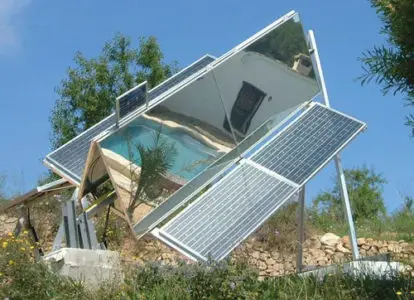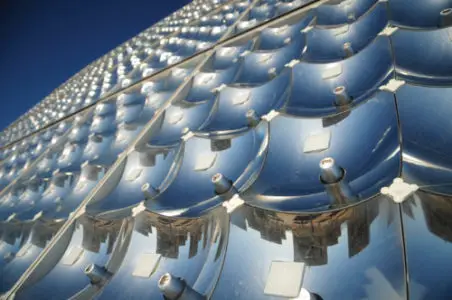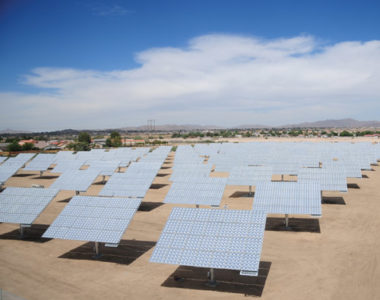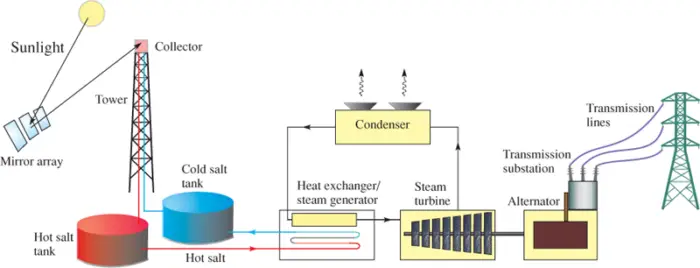A solar concentrator collects light over a certain area and focuses it onto a smaller area. The light can be focused with either a lens or a mirror. For PV systems, the concentrator can increase the amount of electrical power from each cell in the array.
An important application for thermal concentrators is to heat a fluid (often water), which can be used for electricity production or for process heat. Electricity production is discussed in this section.
A solar concentrator uses mirrors or lenses to focus solar energy onto a specific area. Solar Concentrators focus direct radiation rather than diffuse radiation, so they work best in locations with high direct solar radiation, such as the southwest United States.
Three applications for solar concentrators include:
(1) Enhancing the energy on photovoltaic modules
(2) Heating fluids for large electrical power plants
(3) Heating fluids for other applications, including residential hot water, food-processing plants, hospitals, and other commercial applications.
Concentrating Solar Photovoltaic (PV) Systems
Concentrating photovoltaic systems (CPVs) put more light energy onto the PV cells using mirrors or lenses.
Mirrors, which are more widely used than lenses, can be configured to reflect light onto a module, as shown in Figure 1.
In this design, flat mirrors have been installed between two PV modules to reflect sunlight onto the modules, thereby increasing the effective solar insolation as long as the assembly is oriented toward the sun.
If this assembly is not oriented to the sun, the mirrors cast a shadow, negating any advantage. Thus, the array is designed to track the sun.
In this particular collector, the solar energy is nearly doubled at the PV modules by the flat mirrors over the amount that would arrive without the mirrors.
The solar concentration ratio C is the ratio of solar intensity at the collector, with mirrors (or lenses) taken into account over the incident solar intensity without mirrors or lenses.
With other arrangements of mirrors, the concentration ratio can be increased considerably, but heating limits the efficiency and can adversely affect the PV cells, so special cells are used for high concentrations.
Figure 1 Concentrating Photovoltaic Collector Using Flat Mirrors
Solar PV concentrators have two main drawbacks: the need for tracking the sun and heat buildup. Concentrating collectors require tracking to optimize the solar energy collected. For this reason, they are not as widely used on roof installations, where a fixed flat panel is generally more economical.
Tracking collectors are more expensive at the outset, require energy to move them, and require space for the array and between the units (to avoid shadows). As long as space is available, more energy is collected from tracking arrays than from comparable fixed arrays.
Heat buildup is the second problem for Solar PV concentrators. Even low concentration ratios can produce heating problems with standard PV cells and reduce their service life.
Many manufacturers will not honor warranties if their cells are used with solar concentrators. Overheating can result in decreased efficiency and even failure.
High concentration ratios require high-capacity heat sinks and cooling to prevent thermal destruction and reduce performance losses.
Multijunction gallium arsenide (GaAs) PV cells are much better at handling heat than normal cells, but they are expensive. They are usually selected with concentrators in cases where the increased cost of the cells is offset by higher concentration ratios.
These cells are used in the mirror system shown in Figure 2, which has a concentration ratio of 650; thus, each cell sees 650 times more light than a cell on a flat-plate collector. The specific cell characteristics determine how much the system can concentrate light.
Figure 2 Concentrating Photovoltaic System That Uses Small Concave Mirrors to Concentrate the Light on the PV cell
Large PV systems have important advantages in general. One of the most important advantages is the fact that the only water needed for PV systems is for cleaning purposes.
Figure 3 shows a large array at Victor Valley College in the California desert. This large array uses a solar concentrator PV array. The panels have a flat glass cover, which simplifies cleaning. Because it tracks the sun, the system gathers more energy in a day than a comparable flat-panel system with the same collector surface.
In addition, most of its components are recyclable when its life cycle is finished, so there is less waste.
Figure 3 Solar Concentrator Array at Victor Valley College in California
Large Power Plant Arrays
Large thermal concentrator arrays located in high solar insolation areas can produce electricity at prices that are nearly competitive with other methods of producing power.
A key advantage of thermal concentrators using fluids for electrical production over PV modules is that heat can be stored with greater efficiency than electrical energy can be stored in batteries, so the systems can continue to produce power after the sun goes down. The heat is typically stored in molten salts and hot fluids.
For large solar arrays used for commercial power production, the main technologies that have been built or planned and are in the planning phase are parabolic trough mirrors, linear Fresnel mirrors, parabolic dish/Stirling engines, and heliostat mirrors focused on a tower (so-called tower power).
Parabolic Trough Mirrors
Figure 4 shows parabolic trough collectors, which are the most common type of concentrating collectors.
The parabola mirror focuses light on a long tube positioned at the focal point. The parabola rotates on a single axis to keep the light focused on the tube.
The tube carries a special heat transfer fluid (usually synthetic oil) that is heated and the heat is used to power a turbine, which spins an electrical generator.
To be efficient, the system must produce high temperatures for the turbine. Steam turbines are generally used so in this case, the system requires a heat exchanger to move the heat from the oil into the water, which is directed to the turbine wheel and spins the turbine.
Turbines also require cooling to condense the steam and complete the cycle. The most widely used type of cooling system uses water and an evaporative cooling process because it is effective and less costly to install. It requires a large amount of water, however, which is a problem in arid environments.
Cooling water accounts for more than 90% of the water requirements in a water-cooled system. Air cooling is not as efficient as water cooling and is generally costlier to install; however, air cooling may be justified in the desert, depending on the availability of water.
Figure 4 Parabolic Trough Solar Concentrator Array
A new type of parabolic trough commercial plant uses direct-steam generation (DSG) to avoid the need for heat exchangers and to power the turbines directly.
The concept requires recirculating and injection cooling to control the system temperature and pressure for safety system optimization. Superheated steam is directed to a conventional steam turbine.
Several pilot projects using DSG have been tested, and the first commercial operating plant for DSG is now in operation in Malaysia, with a 5-megawatt plant. Other DSG plants are in the planning stage.
Linear Fresnel Mirrors
The concept of the linear Fresnel mirror is basically the same as the parabolic trough mirrors: Direct light is reflected by a line of long parallel mirrors back to a collector that runs along the line of mirrors.
A small space exists between the mirrors, which are often referred to as Fresnel mirrors. They are less expensive than parabolic mirrors, and lighter-weight mirrors can be employed because the spacing produces less wind loading. As a result, the structural supports can be smaller, too.
Fresnel lenses are also being applied to DSG systems by Solar Power Group, a company specializing in linear Fresnel lens technology.
Both parabolic trough mirrors and linear Fresnel mirrors can produce moderately high-temperature heat, which can be used for driving a turbine, heating water, or for other applications such as food processing.
Heat storage is also possible with these collectors because the superheated water can be stored directly or the heat can be stored in salts.
Dish/Stirling Engine Collectors
Another type of solar concentrator under consideration by utilities for power production is the Stirling engine system.
The Stirling engine is a type of heat engine that cools and compresses a gas in one portion of the engine and expands it in a hotter portion to obtain mechanical work.
In a solar energy system, the Stirling engine is used with a tracking parabolic dish to focus solar energy on a hot region of the engine.
The dish tracks the sun in two axes in order to provide the high temperatures required by the Stirling engine for maximum efficiency.
The Stirling engine is a type of external heat engine (unlike a gasoline engine) that is air-cooled and does not require any cooling water. This is an important advantage for desert regions and other locations where water is scarce.
The only water needed in the system is for washing the mirror. Figure 6 shows an array of dish/Stirling engine collectors.
Figure 6 Dish/Stirling Engine Collectors
The Stirling engine was invented in 1816 by Robert Stirling and is based on a closed-loop repeated heating and cooling of a sealed working gas (typically hydrogen or helium). There is no exhaust, very few moving parts, no ignition system, and almost no vibration or noise.
In the solar dish/Stirling engine, the sun provides the heat source, so there is no combustion. The efficiency of the engines can be quite high (as much as 40%) when there is a significant temperature difference between a hot source and cold sink.
The efficiency of a heat engine is proportional to the difference in temperature between the hot and cold reservoirs, so it is an advantage to have a very hot source (hence the large solar concentrator) and a large radiator surface for cooling.
The Stirling engine has a long history, but it has had relatively limited applications because it is slow to warm up and is bulky. But they are very well suited to direct conversion of solar energy to electricity.
Another drawback to the dish/Stirling engine system is that it does not lend itself to storing heat for the times when there is no solar input.
The Stirling engine has many variations, but essentially it derives power from a true thermodynamic cycle of the internal gas.
When energy is supplied to the gas in the form of heat, the pressure rises and pushes against a piston to produce a power stroke. When the gas is cooled, the pressure drops, which means less work is needed to recompress the gas on the return stroke.
The piston drives a mechanical linkage that can do mechanical work as the gas flows between hot and cold heat exchangers.
An important part of the engine is a regenerator, which is a wire mesh that is located between the heat exchangers and serves as temporary heat storage as the gas cycles between the hot and cold sides. The regenerator increases the efficiency of the engine.
The Stirling engine does not have any valves, and the early engines developed rotary motion using an internal crank mechanism connected to two pistons.
In 1964, William Beale invented the free-piston Stirling engine, which eliminated the crank mechanism.
Another refinement was to use the back-and-forth motion of the piston to drive a linear ac generator (alternator) and produce electricity directly (without the need to convert the piston motion to rotary motion). This is the mechanism used in some dish/Stirling engine collectors.
Modern Stirling engines are a model of simplicity, so they tend to be maintenance-free and last for years.
Dish/Stirling engines lend themselves to sloped terrain, so there is minimal preparation work in leveling a site for an array of collectors. They are modular, so a system can easily be expanded if the need arises.
Because the engine efficiency is high, the overall system efficiency is also high: About 24% of the incident sunlight power is converted into electricity.
Solar Power Tower
The term tower power refers to an array of nearly flat mirrors that are all aimed at a receiver on top of a tower, which collects the energy.
The temperature at the collector is the highest of all solar concentrators because of the sheer number of mirrors aimed at one spot.
Each mirror is mounted on a device called a heliostat, which is a device that moves the mirror in a way that keeps the sun on a specific target. The mirrors need to have precise aim at the tower, so dual-axis control is required to track the sun.
The heliostats are individually controlled by a central computer that calculates the direction of the sun from each mirror and sends control signals to motors that keep the sunlight aimed at the receiver on the tower.
The receiver absorbs energy and heats a transfer fluid that is used to drive a conventional steam turbine. The heat transfer fluid can be water, a molten salt mixture, or even compressed air.
Figure 7 shows the basic block diagram of a solar power tower system, with molten salt as the heat transfer fluid.
The heated salt is used to produce superheated steam, which drives a conventional steam-turbine power cycle. Some of the hot molten salt is stored for the system to use in the production of power after the sun is down.
Salt was first used in Solar Two, a demonstration solar power tower in Barstow, California, that was operated between 1996 and 1999.
At one point, the hot salt at night enabled the plant to have a continuous operation for seven continuous 24-hour periods. In arid climates, the condensing can be done by air cooling rather than water.
Figure 7 Block Diagram of a Solar Power Tower System
Review Questions
- What three types of solar systems use concentrators?
- Which type of solar concentrator produces the highest temperatures?
- What type of PV cell is used with PV solar concentrators?
- What is the advantage of a high-temperature difference between the hot source and the cold sink in a heat engine?
- What is DSG and what does it refer to?
Answers
- PV array concentrators, large thermal arrays, and towers, Stirling engines
- Towers
- Multijunction gallium arsenide
- The efficiency of the engine is proportional to the temperature difference.
- DSG stands for “direct-steam generation” and refers to solar concentrator systems that use water rather than oil in the collectors.





